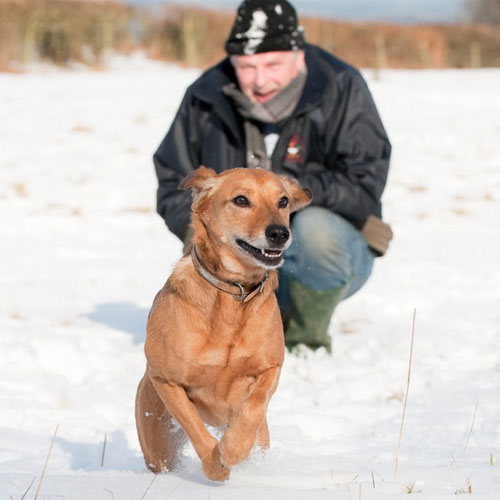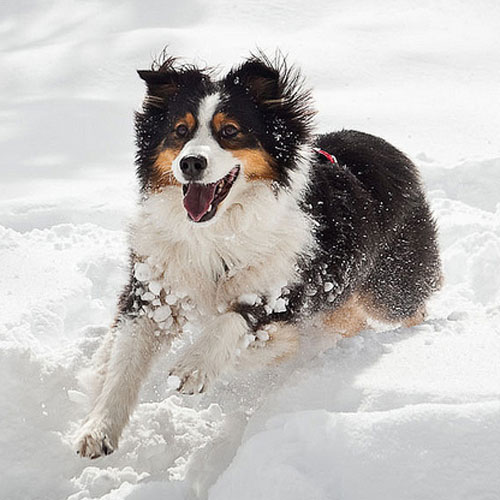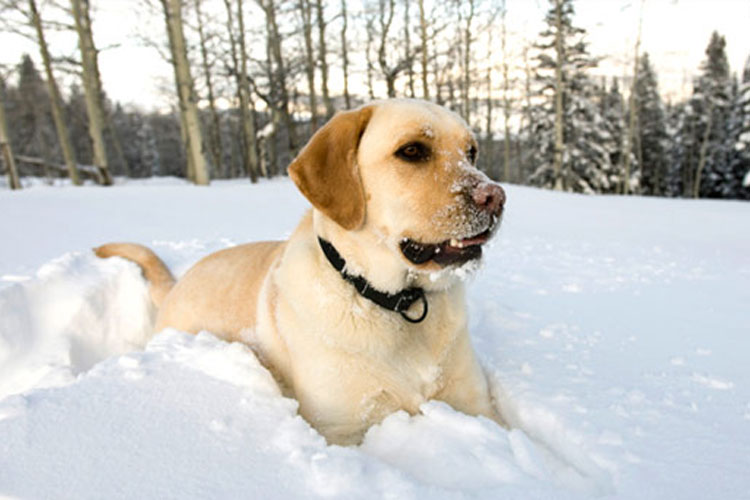Dogs and cats can withstand cooler weather when certain conditions are met. Some breeds are even known to develop heavier coats for colder climates. There are however, some breeds that are not equipped to handle drastic changes in temperatures. Pet owners need to use common sense in order to protect their pets during colder seasons. If you and your pet enjoy the winter months and wish to spend time out of doors, the following information can help you protect your pet from the cold.
ALL PETS NEED TO BE INSIDE IN WINTER. Never leave your pet outside for extended periods of time in the cold, even in a doghouse. When the temperature drops, your pet can get frostbite or even freeze to death. *If you notice a pet being locked outside in the winter, be sure to report it to your local law enforcement and humane officers.

Walks should be brief in frigid weather (25 degrees or less), time out side should be limited to the absolute necessities.
- Large breed and longhaired dogs that are well acclimated may need or wish to spend more time outside. Dog kennels provide temporary shelter, but prolonged periods of extreme cold are still unwise.
- Small breeds, thin dogs, shaved or short coated dogs are especially vulnerable to the cold. They should wear a sweater or coat outside and shouldn’t be outside unattended or for too long.
- Animals under the age of four months cannot regulate body temperature well and will need to be kept indoors.
- Dogs with thin ear tips may also become frost bitten, resulting in the tips of the ears potentially falling off. Be mindful of the time they spend outdoors.
veterinary team.


Be sure to wipe your dog’s feet (and stomach in small dogs) after a winter walk. Rock salt or other ice melting chemicals can cling to your pet’s fur and they can ingest these harmful chemicals when cleaning themselves.
Check your dog’s paw pads for ice balls. If your dog is lifting his feet a lot or seems to be walking strangely, his feet are probably too cold or ice may be forming which can cause frostbite.
Keep your pet groomed. Believe it or not, knotted or matted hair doesn’t insulate properly. Brush your dog’s hair regularly in the wintertime.
Antifreeze is poisonous to your pets. Make sure to wipe up any spills and keep these and other harmful chemicals out of your pet’s reach or path.

Feral and stray cats often take winter refuge under cars and can sometimes even make their way under the hoods. Make sure the coast is clear before starting your car by tapping on the hood and sides to give felines a chance to get away.
Keep an eye on your pet’s water dish to ensure it doesn’t freeze.
Pets should not be left in the car. Most people know not to leave their pets in a car in the summer, but the same goes for the winter. A car interior can get as cold as an ice box and a pet can easily freeze.
Adjust your pet’s diet as necessary. If your dog spends a lot of time outside, he may need more calories in the winter to produce body heat. If your dog spends most of his time indoors and has a decrease in activity, he may require fewer calories. When in doubt, always ask your vet about seasonal diet changes.
If, despite these precautions your pet suffers from exposure to the cold, wrap them up in a blanket and go to your veterinarian as soon as possible. DO NOT immerse your pet in warm water and avoid heating pads that may cause thermal burns.
Related Links:
What Your Dog Needs on a Three-Dog Night
Cold Cat Equals Unhappy Cat: How to Keep Your Kitty Safe and Warm All Winter Long


